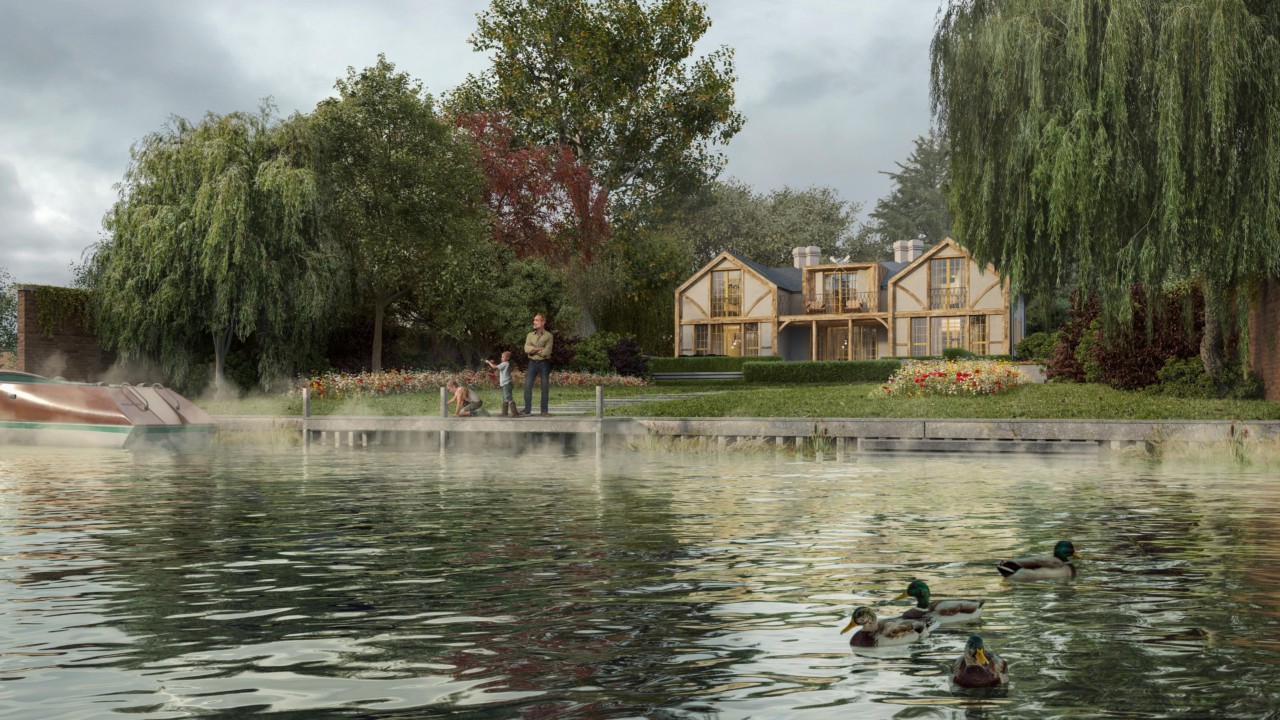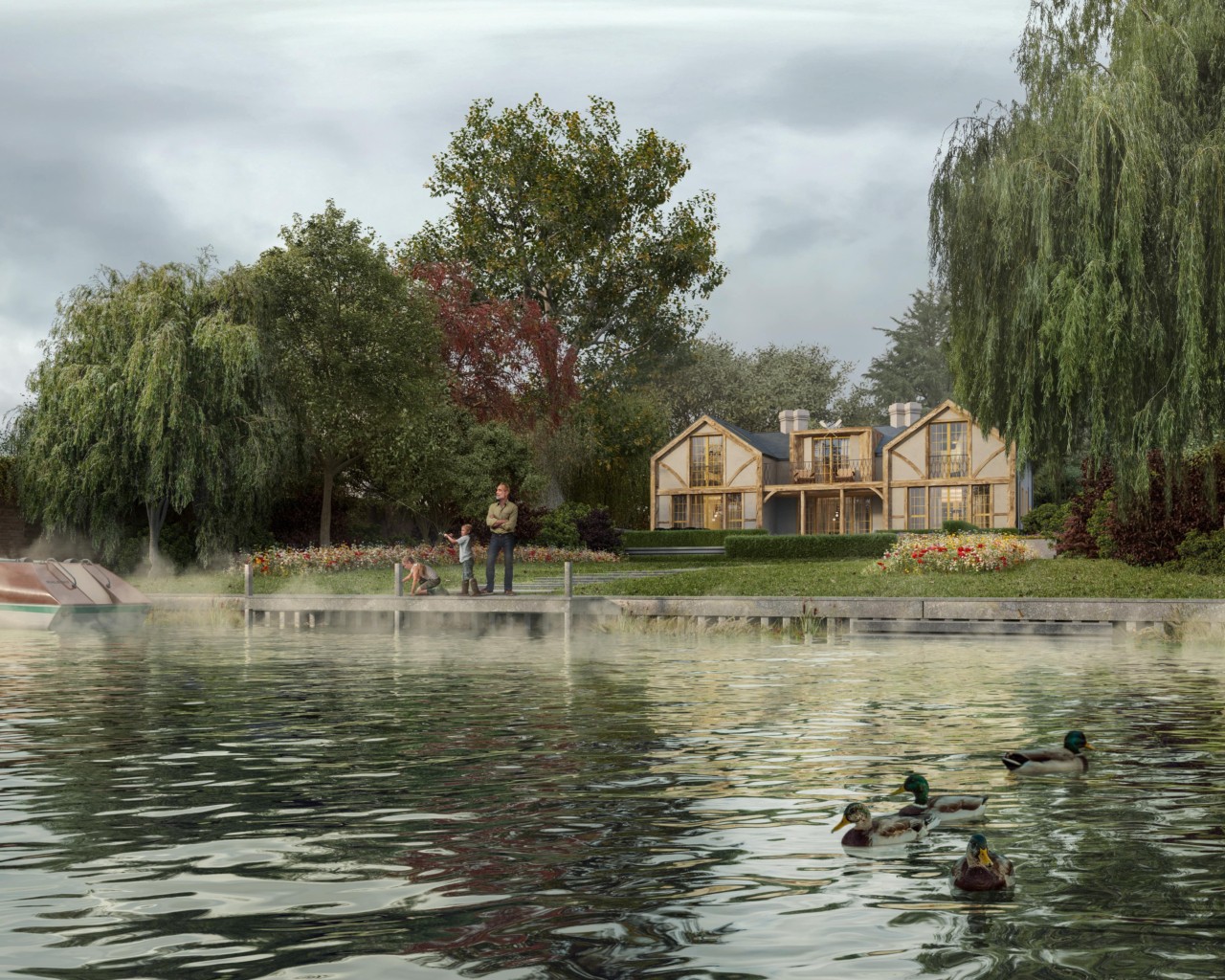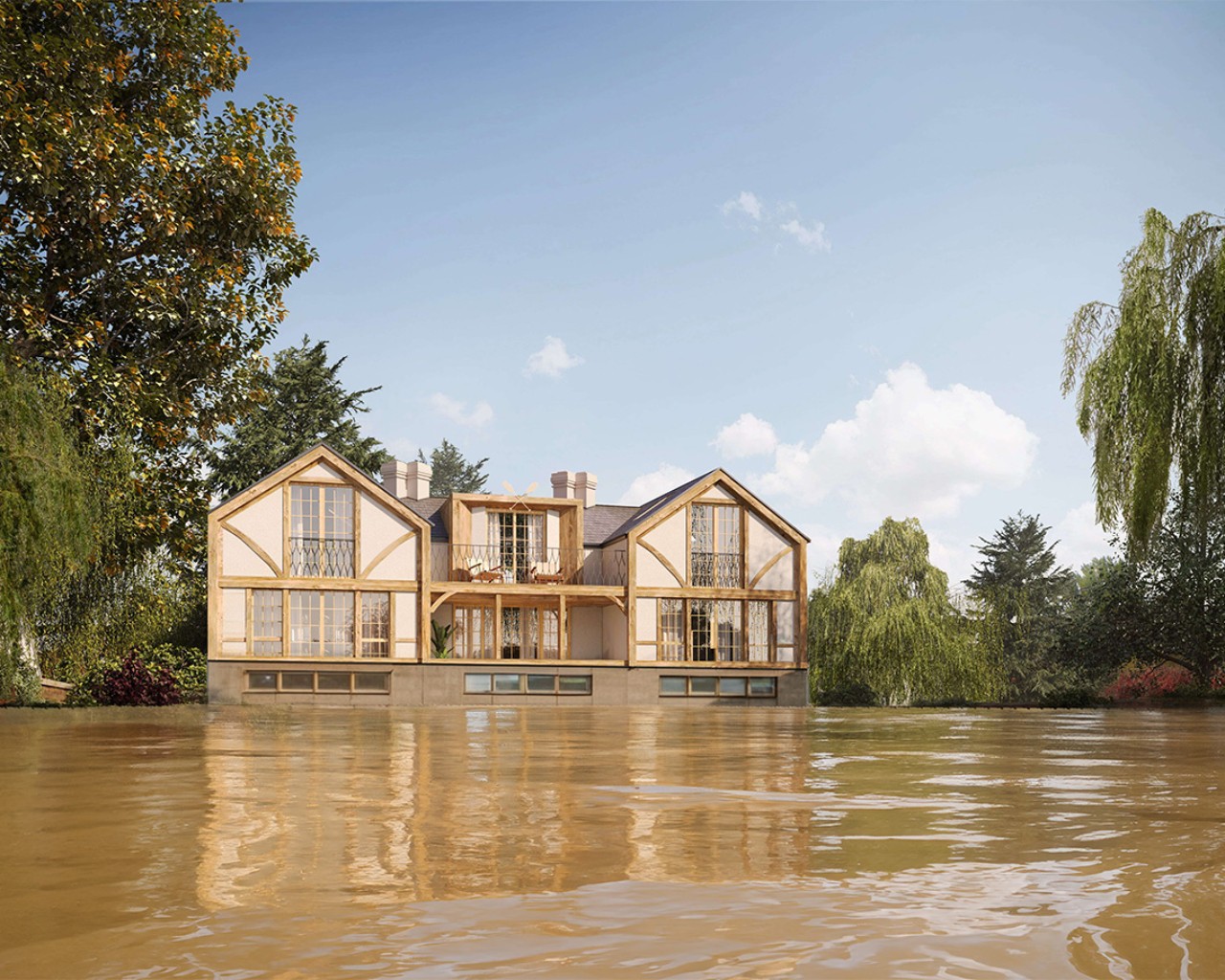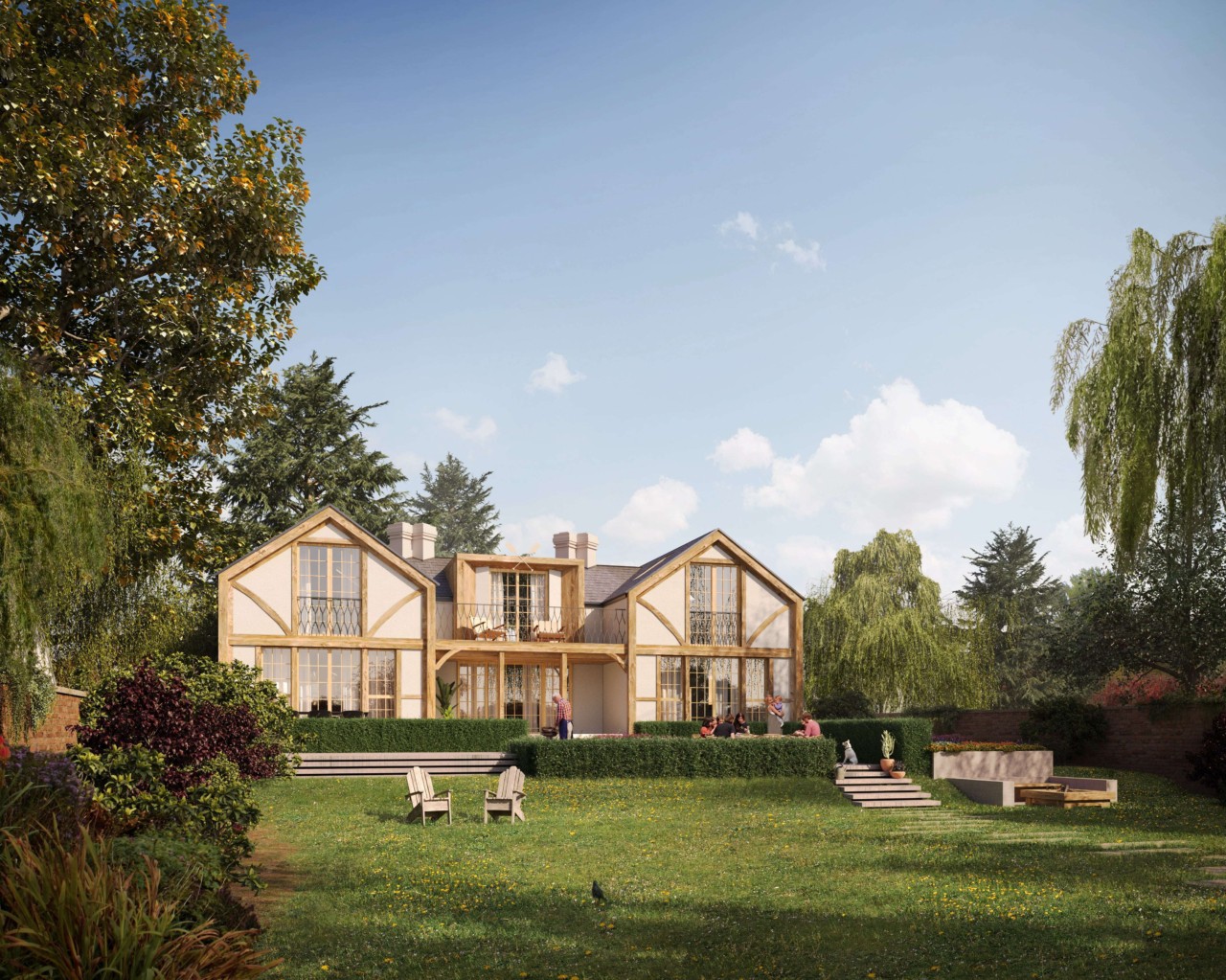

Images courtesy of Baca Architects
WORDS BY CHRIS BARANIUK
With a house like this, it really matters where you plan to put the piano. Because, if a flood comes, the whole building will float—and like a ship stuffed with heavy and precious cargo, this vessel must remain at an even keel.
In October, London firm Baca Architects received planning permission for the Misty River House, an amphibious home on a riverside plot just west of the British capital in the quiet town of Henley-on-Thames. Construction won’t start until late spring or early summer this year, but a team of engineers at the company has already thought about where their client will place hefty possessions—including their piano—and what room they might move such items to in the future.
“It will look like a very traditional English country home,” explained Baca’s cofounder, Richard Coutts, “but in the event of a flood, it can rise.” The luxury abode is set to be the biggest amphibious house in the world.
As storms intensify, seas rise, and rivers break their banks, some architects and homeowners around the world are turning to amphibious homes. Flooding in the United States already costs billions of dollars each year. Even the most expensive property ever listed for sale in the country, a $295 million mansion on the Florida coast, is potentially at risk. That’s what makes a residence that rises with the water line so appealing. While some projects, such as the luxury homes from Baca Architects, are eye-wateringly expensive, it is also possible to adapt existing homes and “amphibiate” them, even on a budget.
Baca Architects’ newly approved, .1-acre property will have a waterproof concrete basement that sits inside a separate sheet steel and concrete “dock” recessed into the ground below. Should floodwater pour into this dock, the water-tight basement—despite its considerable weight—will act like the buoyant hull of a ship, enabling the house to float upward. Guiding columns, colorfully named “dolphins,” will minimize the building’s side-to-side movement as it rises. The home will be able to elevate itself by as much as 8 feet, if necessary.
This is essentially a much bigger version of a house made famous in the United Kingdom thanks to its appearance on Grand Designs, a long-running TV show that follows the progress of people who decide to build their own homes. In 2014, the show covered the construction of Baca Architects’ first amphibious house on an island in the middle of the Thames. The show’s presenter later said the idea had seemed “tinged with madness” but, once completed, it appeared to be a success.
That house has faced floods on roughly six occasions in the last decade, said Coutts. Each time, it rose with the flood and then settled back down on the ground as the waters receded. Flexible pipes link the property to water and electricity so that vertical motion does not damage or cut off utilities. The firm has since completed one other amphibious holiday home in a British seaside town and various other kinds of flood-resistant abode.
“An amphibious house looks normal in a normal situation, and it responds to the flood. That’s the reason for doing it in this way rather than doing something a little more obtrusive.”
“There are many, many scenarios where you have development against the river’s edge,” Coutts said. “It’s one of the most beautiful places to live.” But climate change is making the proposition more dangerous. In addition to sea level rise, hot and dry summers are hardening land near rivers, increasing surface runoff when rains arrive. That swells these waterways rapidly. “The severity of the flooding is compounded,” he said.
An amphibious house does come with some additional maintenance requirements, Coutts explained. You have to clean its base after a flood, a bit like periodically scrubbing a boat’s hull free of detritus. Plus, he said that each year it is advisable to artificially flood the dock in which the house sits in order to confirm that the building still floats as intended.
Besides houseboats, the main alternative to amphibious design is to build a house on stilts. Although amphibiation can cost more than stilts, the former can respond to disasters with greater flexibility. An amphibious house may survive floods of varying levels; with stilts, the moment floodwater exceeds the height of those supports, it’s game over. Additionally, a floating house will not—literally—stand out so much and also won’t face city-planning limitations on building height.
“[An amphibious house] looks normal in a normal situation, and it responds to the flood,” said Jessica Lamond, professor of real estate and climate risk at the University of West England, Bristol. “That’s the reason for doing it in this way rather than doing something a little more obtrusive.”
One other option for homeowners is to place barrier systems against their doors and windows, but these are much more limited in terms of how much floodwater they can hold back.

The riverside house designed by Baca Architects that was filmed for British TV back in 2014 cost $1.5 million to build. While Coutts declined to reveal the expected cost of the Misty River House, there’s little doubt that it will require a tidy sum. But it is possible to live in an amphibious house even if you are not very wealthy, said Elizabeth English, professor of architecture at the University of Waterloo in Canada.
English is the founder and director of the Buoyant Foundation Project, a nonprofit that modifies and retrofits houses with buoyancy devices such as large, plastic, air-filled barrels. One of her students conducted a case study in Bangladesh that showed it is even possible to float a house by packaging together hundreds of empty plastic bottles and strapping them to the base of a residence. English notes that this isn’t a practical approach in developed countries, however, as it wouldn’t pass building codes. To date, she has amphibiated four homes and produced two prototypes. Her retrofit strategy can cost as little as several thousand dollars, she said.
English noticed how devastating flood damage can be for buildings after Hurricane Katrina in 2005. “I was doing a post-event assessment of the wind damage, going back and forth from Baton Rouge,” she recalled. “It was obvious that the big problem was not the wind.” After levees failed, flooding caused widespread damage in Louisiana, affecting roughly 80% of New Orleans, the fifth biggest city in the U.S. Many families still feel the financial consequences of Hurricane Katrina nearly two decades later.
In an increasingly wet and flooded world, some homeowners will soon find themselves choosing between one of three options: relocate, live in a floating home, or try to keep floodwaters out with walls and barriers.
Installing flotation aids is relatively easy when a house is built atop a void or crawlspace, said English, though some properties, such as stone-built houses with fixed basements, would be more challenging and expensive to amphibiate. Mobile homes or period homes built with relatively light, timber frames also make good candidates.
However, there are some limitations. Strong rushes of water can be particularly damaging to built infrastructure in coastal areas or places where floodwaters can rise very quickly, English pointed out, which makes amphibiating a house in these locations even more of a challenge. There are ways to minimize the damage, such as securing the guide posts to deeper foundations to prevent them from shifting. However, that would likely raise the cost of the retrofit and still might not prevent damage to the house, which is the bigger problem, said English.
Such cases aside, there could be huge benefits to making existing homes amphibious. Some of the world’s most marginalized communities face the greatest flood risks. These residents may be unable to afford to move inland or build a new home entirely, but retrofitting could be a feasible option.
Plus, moving away from a flood-prone area is often not acceptable—including for many Indigenous communities who have long-standing ties to particular places.
“That’s my goal: to maintain the culture that these communities have, even though they’re at risk,” said English. “They’re the people who have contributed the least to climate change and are being affected the most.”
To that end, her latest project is a house for a First Nations client in the Canadian province of Manitoba. It will be a modular home, a type of prefabricated building designed to be relatively easy to assemble on-site. Once constructed, English plans to immediately retrofit it with devices that enable it to float in the event of a flood. She’s scheduled to carry out the work this summer.
While amphibious houses appear to be gaining traction in some places, English noted that building codes in various countries around the world still don’t allow for these designs. Coutts added that Baca Architects’ approach to amphibious architecture is currently not possible in the U.S. because of regulatory hurdles.
In an increasingly wet and flooded world, some homeowners will soon find themselves choosing between one of three options: relocate, live in a floating home, or try to keep floodwaters out with walls and barriers. The latter approach, while long-favored by some, is wrong-headed, argued English. Working with the flood, rather than against it, may serve people better in the long run.
“If you’re going to pick a fight with Mother Nature,” she said, “Mother Nature’s always going to win.”

A Plan to Build the Biggest Amphibious House in the World


